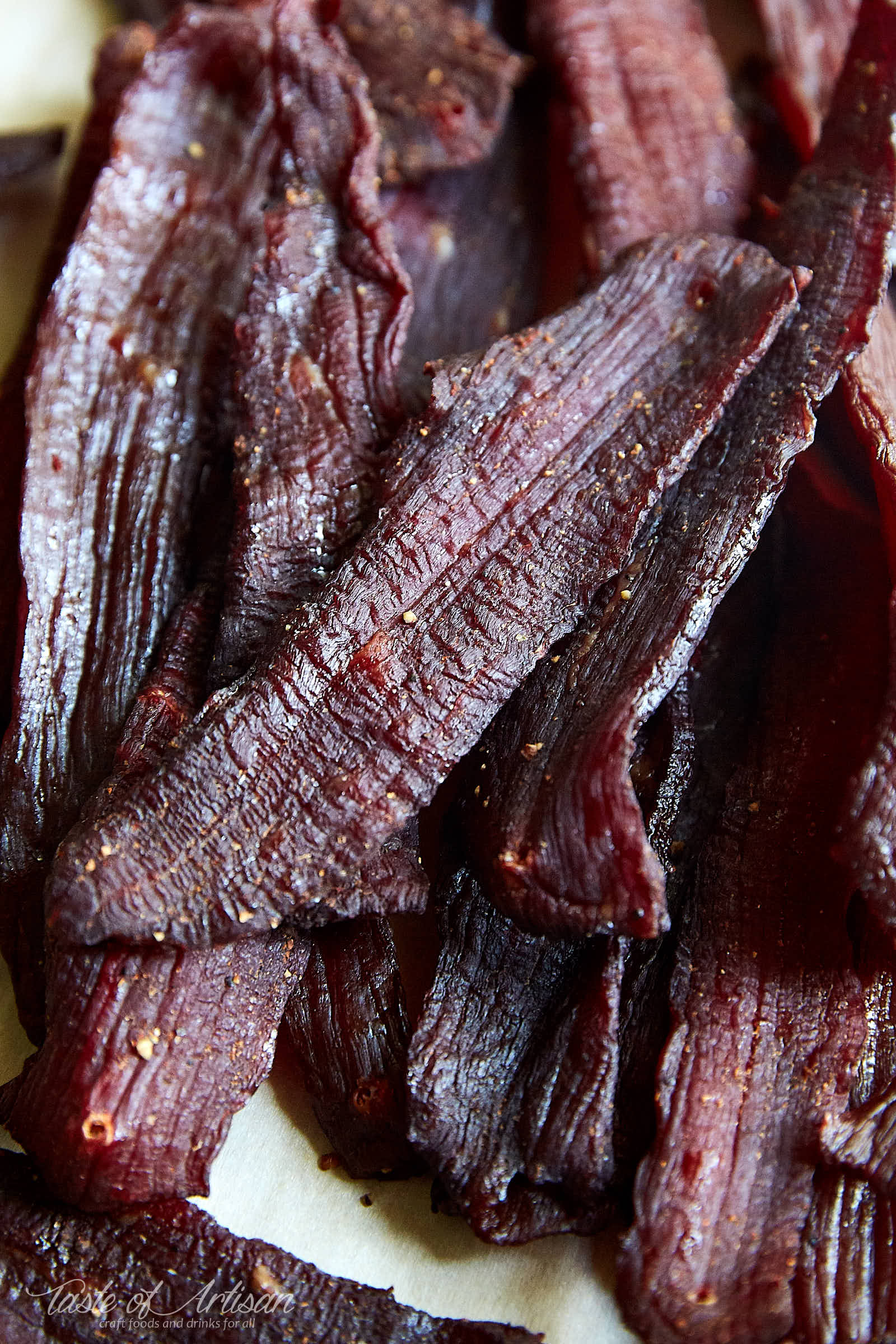
Oven-drying is probably the most readily accessible method for making beef jerky at home. I wouldn't say that it's the easiest method - a dehydrator wins here - but everyone has an oven in their kitchen. I've been experimenting with making beef jerky in my electric oven and I am happy to say that I have finally achieved the results with which I am quite happy.
When making beef jerky in the kitchen oven, you need to pay attention to these four important things:
- Meat selection
- Food safety
- Temperature
- Air ventilation and circulation
Selecting meat for beef jerky
There is no best meat for jerky. Any lean meat can be used to make it. I read somewhere that meat for jerky needs to be 93% lean or higher. This is because beef fat does not dry well and becomes rancid quickly. That said, nowadays we make beef jerky not for it's long shelf life without refrigeration but for its taste. In my house, a batch of jerky doesn't last long enough for fat to become rancid.
Fatty jerky, without a doubt, tastes awesome. It's also easier to chew. I tried it once from Big John's Beef Jerky - my favorite artisan beef jerky maker - and got hooked for good. However, making fatty jerky in the oven may be problematic as kitchen ovens' lowest temperature settings aren't low enough not to melt fat and make your jerky greasy.
Commonly used beef cuts for making jerky:
- Eye of round
- Flank steak
- Top round
- Bottom round
- Sirloin tip
- Chuck
- Skirt steak
It makes financial sense to go with the cheapest cut you can find.
Beef jerky and food safety
There are several methods that are commonly used to ensure that beef jerky is safe to eat. USDA recommends to "steam or roast meat to 160 °F before dehydrating it". The reason for doing that is to destroy any potential pathogenic bacteria (e.g. E.coli and Listeria) present in the meat. One way to achieve that is to place meat in an oven at 275F for 10 minutes.
Stanley Marianski in his Home Production of Quality Meats and Sausages book suggests, as an alternative, to boil the meat for 2 minutes in the marinade, if you have enough, or in a separately prepared brine.
What is Cure #1 (Pink Salt) and should I use it when making jerky?
You will find a number of recipes using pink salt or curing salt when making beef jerky. This is a necessary step when making dried or cured sausages to ensure that they are safe to eat. Curing salt, or Cure #1, contains a small amount of sodium nitrite, which helps prevent harmful bacteria growth. It also improves color of the meat (pink as opposed to grey) and enhances its flavor.
Cure #1, also known as pink salt, is regular salt and only 6.25% sodium nitrite. Typically, you would use 5 grams or 1 level teaspoon of Cure #1 per 5 pounds of meat.
Morton sells a different product called Tender Quick, which serves a similar purpose but the ratios used are different. Follow the instruction on the package to see how much of Tender Quick you need to add per specified amount of meat.
Drying temperature
Traditionally, beef jerky is dried at around 145F. In the kitchen oven, you will have to settle with the lowest setting available. Most kitchen ovens don't go lower than 170F or so. This will result in a slightly different texture of the jerky as compared to other production methods.
To make oven-dried beef jerky safe to eat, it will be initially heated to 160F in an oven at 275F. This process will take 10 minutes.
Air ventilation and circulation
As common sense would suggest, drying beef jerky means removing moisture from the meat. Hence, it's important to ensure that your oven has an efficient way of removing moisture throughout the drying process. Oven vents are not sufficient for that. You will need to crack open the oven's door and keep it like that while you are drying jerky. A wooden spoon will come in handy for keeping the door ajar.
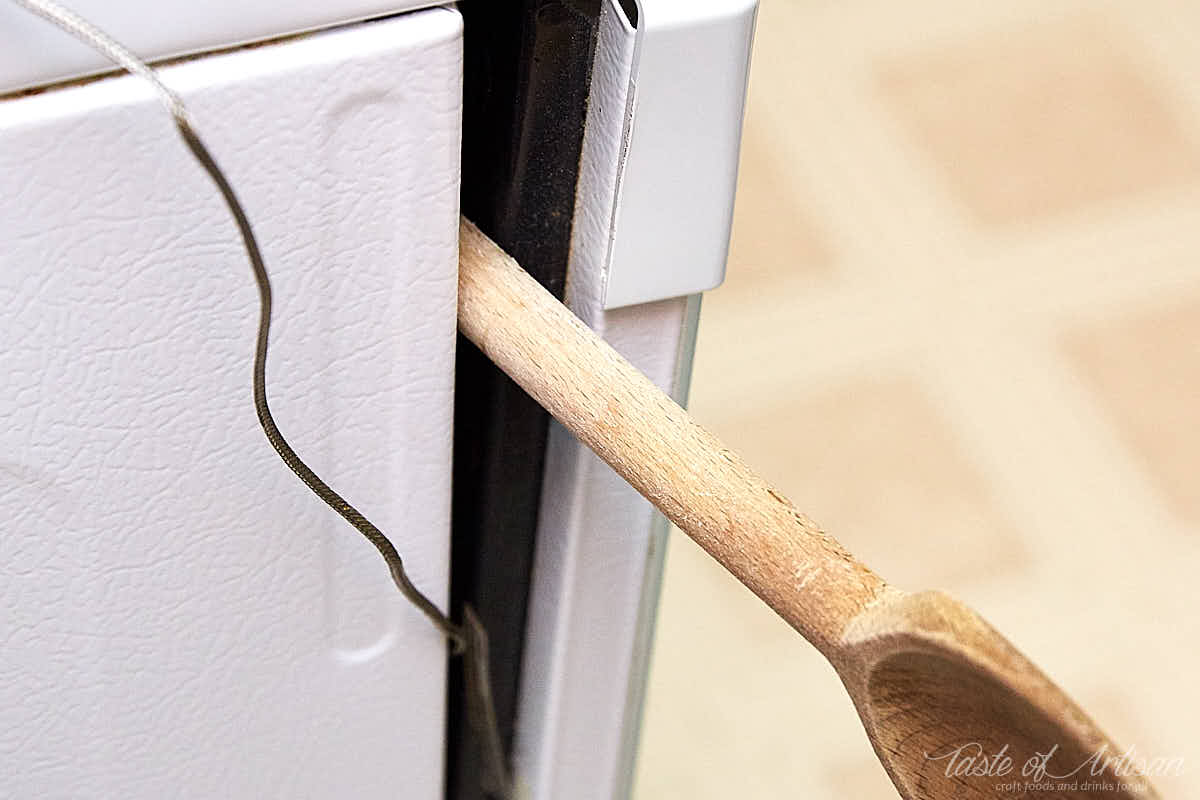
If your oven has a convection fan, it may be a good idea to use it as it will greatly expedite drying time. With the door open, you will need to find a way to the keep the button down for convection to work. Also, if the air flow is too strong, you may want to place something between the fan and the jerky to disperse the air stream from the fan.
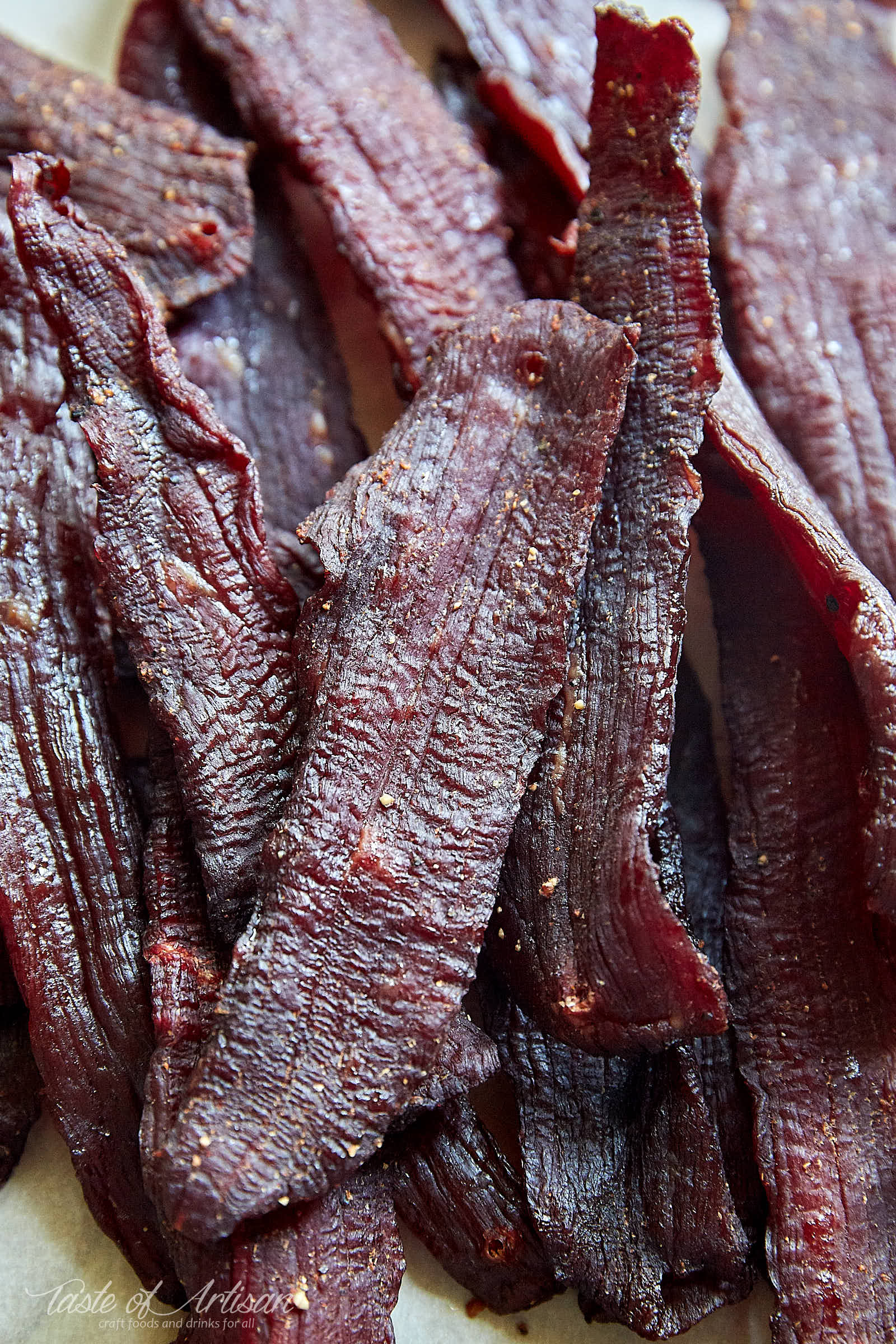
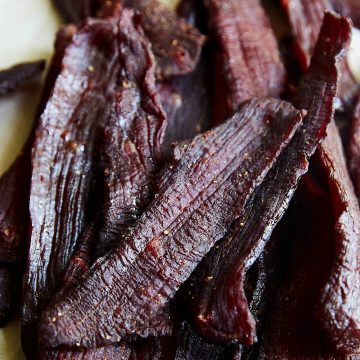
Ingredients
- 3 lb meat (93% lean or higher)
For the marinade:
- 1 tsp red pepper flakes (plus more to taste)
- 1 Tbsp garlic powder
- 1 Tbsp onion powder
- 1 1/2 tsp freshly ground black pepper
- 1 cup Worcestershire
- 1 cup soy sauce (regular, not low sodium)
- 1 Tbsp liquid smoke (optional; use if you want to add smoky flavor)
- 1/2 tsp Cure #1 (heaping; optional but strongly recommended)
Instructions
- A lot of beef cuts come with a fat cap. Trim the fat off and cut the meat into manageable pieces that will be easy to slice. Then put the meat in a plastic bag and put in a freezer for a few hours. Freezing will firm it up and make it a easy to slice evenly.

- When the meat is firm, slice it about 3/16" - 1/4" thick. Thinner sliced meat tends to come out dryer and less chewy. Thicker will take a long time to dry.

- To make the jerky chewy, slice it along the grain.
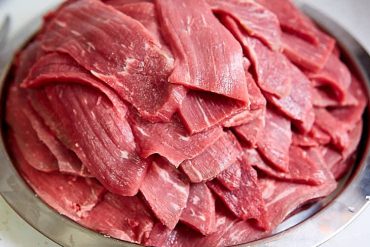
- To make the jerky less chewy, slice it across the grain.
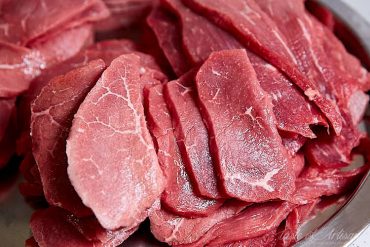
- Combine all the ingredients for the marinade in a large Ziploc bag and shake.
- Add the meat slices, shake and massage the meat really well.
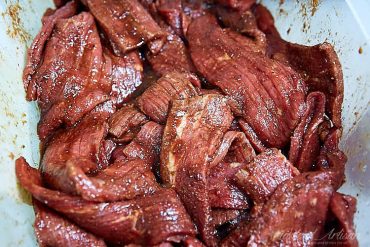
- Refrigerate for 24 to 48 hours, flipping the bag and massaging the meat every 6-8 hours. Strictly speaking, marination is not necessary, but it makes jerky much more flavorful inside out and tenderizes tougher beef cuts.
- Remove one rack from the oven so you can start hanging the meat slices on it. Meanwhile, preheat oven to 300F.
- Hang the meat on the oven rack. The most efficient way is to hang the meat slices vertically, as shown on the picture below. This way you can have about 5 lbs of meat on one rack, properly spaced out.
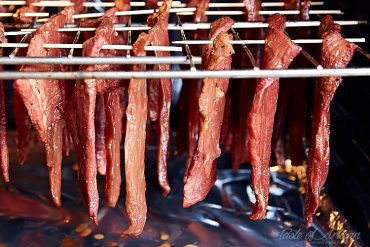
- Once the oven is preheated to 300F, bring the meat in, close the oven door, turn the temperature down to 275F and bake the meat for 10 minutes. This will bring its internal temperature to the safe level of 160F.
- Drop the temperature further to the lowest setting your oven can go, e.g. 170F. Crack open the oven door and insert a thick wooden spoon to secure it in that position.
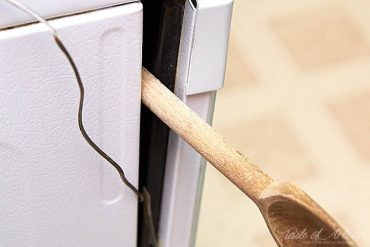
- After about 30 minutes, when the temperature in the oven has stabilized at its lowest setting, turn on the convection fan, if you oven has it. It will expedite the drying process. You will have to find a creative way to keep the button down to activate convection.
- Continue drying jerky until it's ready. The jerky is dry enough when it bends without breaking, while surface develops cracks when you bend it. This will take anywhere from 4 to 8 hours, depending on whether you use convection and the thickness of meat slices.
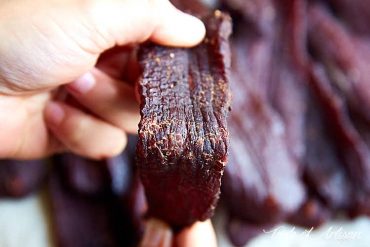
Notes
Oven beef jerky - the results
I did a direct comparison of oven-dried beef jerky to the famous Jack Links. The texture was quite similar. Jack Links jerky was a little more bendy and did not crack when bent. It also was softer and more moist due to a variety of additives that it uses. Oven-dried jerky wins in my book. It tastes more traditional and natural. I also preferred the flavor of the oven-dried jerky.
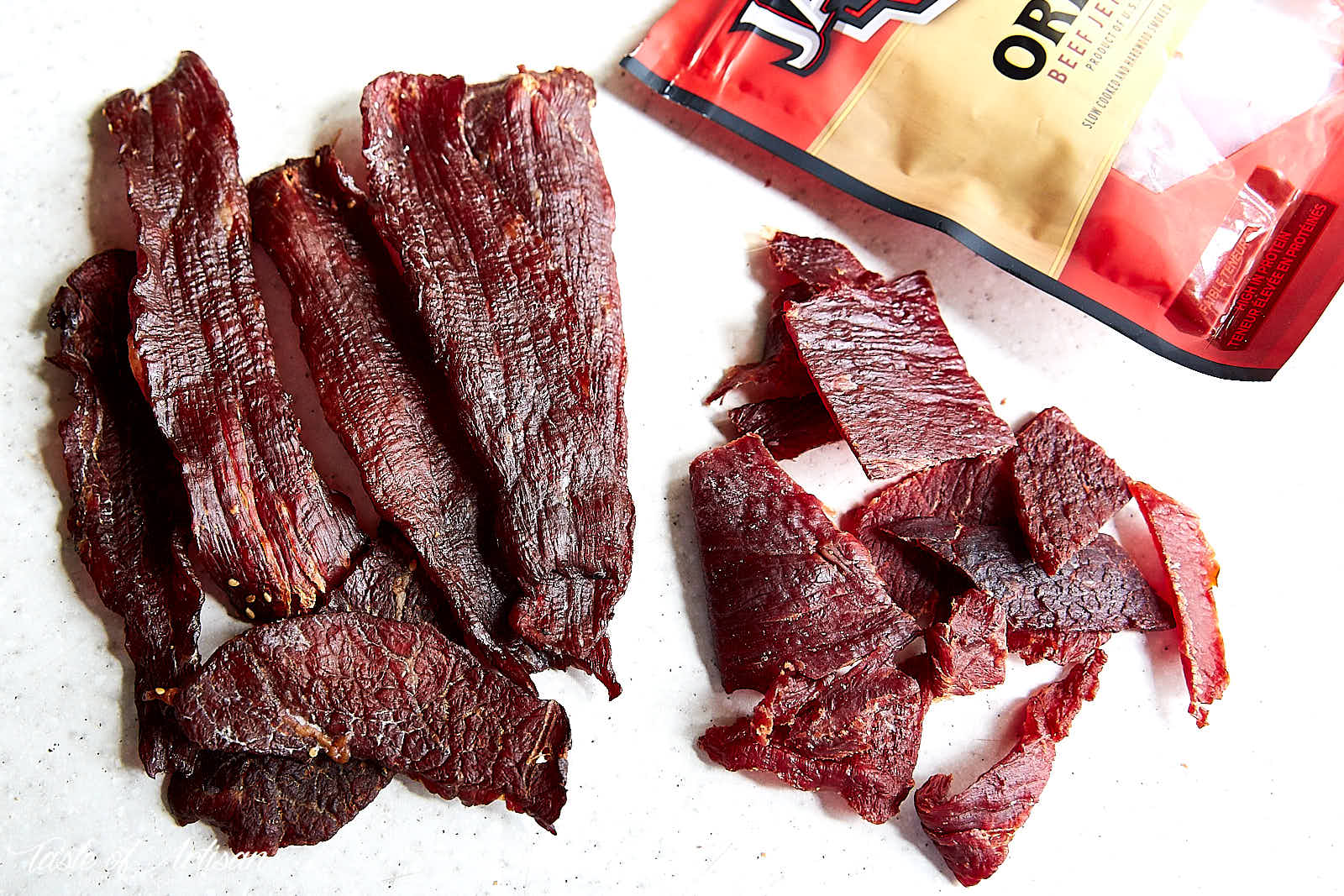
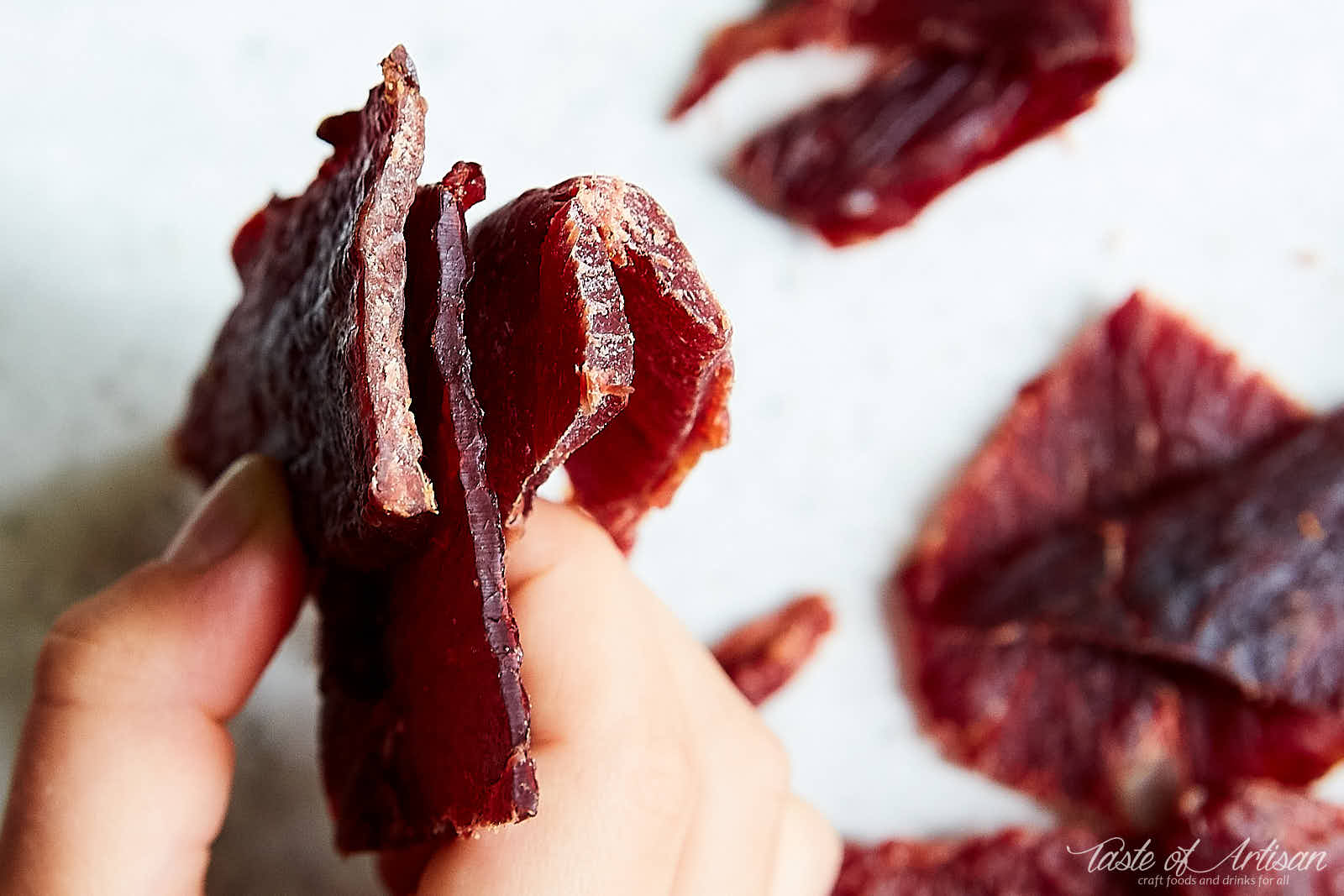
This post was updated on January 26, 2019


Eric says
i’m late to the game, you may have already addressed this. anyway, can you use pork tenderloin using this method? Wouldn’t be too dry, or should I just shorten the amount of time in the oven?
Many thanks
Victor @ Taste of Artisan says
Eric, I haven't tried pork tenderloin jerky using this method so it's hard for me to comment on it. Perhaps someone else who did will chime in. Good luck!
Kim says
What is the shelf life of home made jerky? Thank you!!
Victor @ Taste of Artisan says
It depends on how well you dry it. Well-dried jerky will keep 1-3 months in an air tight container or a ziploc bag. Vacuum sealed it will store for up to 6 months. Vac sealed in a fridge or freezer it will store even longer.
Markay says
Hey Victor,
I'm Markay from Offbeat Discoveries YouTube channel. I'm doing a video on beef jerky. I wanted to refer people to your web page. Can I have your permission to show the pic of meat hanging with a pic of your web page in the video?
Thanks, Luv!
Victor @ Taste of Artisan says
Hi Markay, I appreciate you reaching out to me and, yes, you have my permission. Thank you. Happy New Year!
Markay says
Thank you, Victor. I so appreciate your fast reply and your wonderful website. Happy 2024 to YOU as well.
Victor @ Taste of Artisan says
You are very welcome!
BC says
Enjoyed this very informative and helpful site on drying and curing meats. I once was sailing and we caught a large tuna. We ate very well that nite but had no refrigeration to keep remainder. I made a mix of soy sauce,ground black pepper and salt and kept thin slices overnite then in day would put out on the grill where the sun and the passing breeze(we were sailing) covered it at nite then opened in AM took three days to dry but it was delicious and kept very well.
Victor @ Taste of Artisan says
Cool! You've experienced an ancient fish preservation method. I love diried fish, by itself or with a glass of cold beer. As a kid, I used to fish a lot and air/sun dried most of my catch. It was delicious.
Jean says
American jerky is horrid..
Once u try south african biltong you will never eat jerky ever again..
Easier to make too...less fuss..
Meat is not cooked nor baked..its only marinated and airdried....and perfectly safe to.eat..
Victor @ Taste of Artisan says
I am glad sun-dried biltong works for you; it's a fine meat when done properly, just like any other meat, including American jerky. It sounds to me that you have yet to try good jerky, otherwise you wouldn't be saying stuff like that. In any case, let's keep it civilized going forward.
Jennifer says
Oooooo,!!! Sounds interesting!!! Is there a recipe available??😊
steve taylor says
Hi there. Thanks for this Bodacious jerky recipie. I thought I was Doomed because my oven bottoms out at 170 which you said was a wee bit hot so I experimented with varying degrees of how big of a wooden spoon it would take to bring the temperature down. So I grabbed my trusty IR heat gun and started with about a 3 inch opening and started shooting. Turns out that 2 inches at the top worked for me to get it at 155. Turned out Bodacious. Thanks for sharing and cheers from Saskatchewan....hard to spell...easy to draw.
Victor @ Taste of Artisan says
You are very welcome. Thank you for the feedback. No kidding, it IS easy to draw LOL. Like Colorado, or Wyoming.
Jerri says
Been using this recipe for years, the best jerky recipe there is.
Victor @ Taste of Artisan says
Awesome!
Mantas says
Hi Artisan! Great recipe, very detailed! Just quick question if I cure beef strips with salt and spices in the vacuum seal bag for a week or more, do you still need to fry it or cook it at 275ºF for 10min? Or at that point the meat is safe to eat?
Also is there a formula like dry aging food, for example beef jerky is good to eat when it lost 40% its weight? I tried 40% weight lost but seem that I would like it to be a little more dry. Also when it cools down from the oven and after being in fridge the moister will still be absorbed a little bit back to the jerky.
Pictures look awesome!
Victor @ Taste of Artisan says
Mantas, the idea behind cooking the meat at 275F for 10 min (this is just one way of doing it) is to raise the internal temp of the meat to 160F to kill off harmful bacteria which may not be destroyed during drying at low heat and become heat resistant and survive. This is what USDA recommends for making beef jerky. Curing meat with salt/curing salt in a fridge does not make it safe to eat, it needs to be cooked. Bacon is a good example. Dry-curing is a little different. Meat cured in a fridge for a week in a Ziploc bag is then dried/matured, after which meat is safe to eat. Dry-cured meats need to follow their own standards for safety, those are a minimum salt level, pH drop to 5.3 or lower, and a max water activity. Those ensure two things - harmful bacteria growth is inhibited as much as possible and any existing bacteria will deactivate to the minimum acceptable level over the drying/maturing time. While jerky can easily meet the requirement for water activity (dryness), there other two hurdles are usually not met. Hope this helps. I have many recipes for dry-cured meats and bacon, check them out.
Babs says
Lol you both forget. America has a high humidity rate, whereas Africa is very low. Hence Africa meat does not become spoiled quicker. I am a cook and have worked in Africa, it’s amazing to see the difference traditional cooking is down there compared to here.
Victor @ Taste of Artisan says
That's a very good point, Babs. Thanks for another perspective on this.
Jon says
Very interesting. As a biltong maker just a couple of observations. Firstly I've never had fat in beef biltong go rancid. I normally hang for up to a week in my drier but typically in South Africa drying times could be as long fourteen days In open air. To give an idea, we could be hanging half inch thick strips, 12 inches in length with a half inch wide strip of fat along the length. They only thing I could think of is the jerky getting too hot? Secondly I'm suprised at the need to use both Prague Powder and heat. Strips of biltong are simply salted, spiced and hung. Salt is the main ingredient and everything else added is for flavour. Would your ancestors have heated the meat prior to making jerky? Having never had properly made jerky I really would like to try it. Hopefully one day I will get to do so. 😀
Victor @ Taste of Artisan says
Hi Jon,
thanks for your comments. I see where you are coming from. But you know, on the one hand, we have USDA recommendations here which commercial jerky makers have to follow. I tend to follow those as well to be on the safe side and I would not want to post on my public blog anything that may make someone sick. On the other hand, we have traditions and traditional ways of curing, smoking and drying meat that don't care about what USDA has to say as those recipes have worked for centuries. Those can be safe too but you have to know what you are doing and have the freshest meat from a trusted source. I like using Prague Powder though as it does add flavor, color and it also prevents harmful bacteria growth. I see your point about heat and Prague Powder but we deal with low heat here over a long time, which puts the meat in the danger zone for hours.
As far as using fatty meat for jerky and fat rancidity goes... what I mean is that, yes, beef fat gets rancid over time faster than pork fat. I've seen that in my dry-cured sausages made with beef and beef fat. Pork fat also goes rancid given long enough time and exposure to light/air. But is that an issue for us home jerky makers? In my case, that jerky doesn't last long enough to get rancid. I think it will be the case for most people. I also store it in the fridge as I don't have to keep it unrefrigerated. So, fatty should not be an issues if we are not looking for a very long-term storage.
I've been buying beef jerky every now and again from this one place that I love (Big John's Beef Jerky) and some time ago they started selling fatty beef jerky. It's made of the same meat cuts but some just happen to be fattier, more marbled. I have to say, that's the best jerky that I have tasted. A little bit of fat makes meat taste better. I've been making this type of fatty jerky in my smokehouse as well and I like it a lot.
Han Le says
nice
Patricia says
Looking forward to trying this with my grandson. He’s quite the adventurous young man. I thought making it would be less costly than buying, and we would be sure of all the ingredients.
Victor @ Taste of Artisan says
Good luck. Let me know how it turned out.
Rebecca says
Hi I want to make jerky that we can store in container for long time
Victor @ Taste of Artisan says
Rebecca, if you want to store jerky in a container for a long time, you must use pink salt/Cure #1 and dry well, then store in an airtight container. It's not always easy to say when the meat is properly dried (all the way to the center) without a water activity meter though and those are quite expensive for a home user.
Cassie says
How long and how do you recommend storing the beef jerky?
Victor @ Taste of Artisan says
To be on the safe side, I always store in the fridge. If using Cure #1, they can be safely stored in a fridge for months in theory, but in reality, every batch I've made was devoured within days. Without the cure #1, it can store in the fridge for weeks and even months if it's dry enough.
T Abdo says
Great recipe for oven jerky. I used to use honey in the marinade as well for some really sweet delicious jerky. Now I'm on keto, so I substitute the Worcester sauce for shiitake mushroom juice (the leftover juice after rehydrating dehydrated shiitake mushrooms). Five stars!
Kathie says
Using my own marinades...already done! Just looking for a way to use the oven. Sounds like a tried and true way. Looking forward to the results. Thank you.🤗
Victor @ Taste of Artisan says
You are very welcome. Enjoy!
Candace says
Thank you for the wonderful gift of this very well researched recipe that you did. I would pay for this recipe it is so great and valuable. I am so happy to get it.
Victor @ Taste of Artisan says
You are very welcome, Candace and thank you for the kind words. Happy cooking!
Torrey says
Can you use pink Himalayan salt instead of Cure #1 to enhance the color?
Victor @ Taste of Artisan says
Pink Himalayan salt won't have the same effect on the color of the meat.
Alvar says
A bit late, but well.
Color enhance has nothing to do with the color of salts.
Himalayan salt, which in many places is a commercial name nowadays, is salt with some iron in the composition.
Cure salts have other salts other than common sodium chloride, or whtever you call the common salt table.
The addition of sodium nitrite (for the #1) and this, plus sodium nitrate (Which are in cure #2) was discovered in Italy centuries ago as a meat preserver, and antioxidant.
Later on it was found that a dangerous deadly bacteria, called Clostridium Botulinum, was not present whenever nitrite was present, so it was used as an additive ever since.
Nitrate is just nitrite for the long run, since it changes to nitrite naturally in the after several weeks and months.
Usually #1 is used for cooked and smoked meats and salumis, since its short preparation time, and #2 for dry salumis and salamis, which take longer to be ready to eat, sometimes months and also more than a year, depending which salumi is.
Having said that, all these cure salts are also naturally white, but pink colored so can be diferentiated instantly from the normal salt.
Many sausages etc has "no nitrites added" label in commercial industral products, but their trick is to go with the celery salt, which has quite a bunch, since this plant packs quite some of antioxidants.
Sorry for making this loong and boring, but I've seen many people trying to bend the recipes for misinformation, in order to fit their innocent beliefs, which in some cases, can bring body harm or worse.
-----------------
Loved the recipe, Victor !
But quite frankly I stick with biltong... kudu, impala, you name it. XD
Victor @ Taste of Artisan says
Thanks for the fantastic write up, Alvaro. Oven jerky is just one of the things you can easily make at home, the beauty of home of home cooking is that you can try just about anything you like and make it how you like it.
Eric R says
My oven goes down to 100° Can I use that temp. I did preheat at 300 for 10 min just curious if I should go down to 100 or not. Or should I go with 145 ?
Victor @ Taste of Artisan says
Eric, 100F is too low, it will take a loooooong time to dirty at that temperature. Instead, shoot for 135F - 145F.
Levana Kirschenbaum says
It looks wonderful.
Question: my oven racks don’t have that opening that allows you to string the strips through. What other logistics can I use to hang the strips vertically safely on the rackets? Butcher string? Other? TIA
Victor @ Taste of Artisan says
Levana, I'd like to see what your rack looks like so I may be able to advise, otherwise, I am in the dark here. I'll send you an email.
Vanessa Smith says
Awesome Recipe!!! First time making jerky, very pleased with flavor and texture. Cook time was about 4 1/2 hours.
Roger Moon says
I did ur receipt but without the salt due to my heart condition. AMAZING!! taste and texture. The whole family enjoyed the Jerky, especially my Grandsons! Thank you for putting it where everyone can do it. God Bless you.
Victor @ Taste of Artisan says
So happy to hear that, Roger. Glad your family enjoyed the treat you made for them. That so rewarding!
J.Shoals says
We love your jerky, made it 3 times already. Great recipe!
Ron denniel says
I never put wooden spoon in door. I just open door let steam out every 30 minutes. About 4 or 6 time total.
Victor @ Taste of Artisan says
Thanks for the input, Ron. There are many good ways to make jerky, without a doubt.
Curtis says
Hello
Why can’t you use regular table or sea salt?
Also can you sub nitrate with chemical tenderizers and use baking aids to tenderize the meat a little?
Victor @ Taste of Artisan says
Curtis, I use kosher salt in cooking because it's more pure and is fairly consistent from brand to brand. Any other salt will do too. Table salt, because of its smaller granules, will need to be adjusted as a Tbsp of table salt will give a lot more salt compared to kosher salt. Sea salt of good quality is a very good alternative and I use it as well. Himalayan salt is another good alternative.
Janet says
If you live in hot weather. You cant make jerky outside in rain or damp weather. you put wires up and put wax paper on the lines. Cut your meat wide enough where you cut thru the middle to make a v. Put the meat on the wire be sure and salt & pepper it real good. Just plain ole table salt. Wait Full day or two pull them apart. Then wait for 4 to 5 days if hot outside or in shed. When you get your jerky off the wires put it in cotton pillow case. Will last for long time. Grind your dry jerky and make biscuits and jerky gravy. I'm 81 and grew up on jerky . My dad would make bags full. Ohnyes loved the fatty pieces of jerky. Never had one tainted
John C. says
Thank you for the great recipe and detailed instructions. For the first time after many failed attempts was I able to make my first successful batch of beef jerky. My family loved it so much that the whole 4-lb batch was gone within a few hours. Will be making again soon for sure.
Gabor says
Hi!
I am going to make some (hopefully) tasty jerky this weekend following Your recipe. This is my very first attempt. (Never dried meat before either)
I can set my oven’s temperature to 50˚C (122 F).
Should I choose this temperature or is it better to choose 170 F? How much does the temperature alter the drying time?
It is important to leave the door open either way I suppose.
Victor @ Taste of Artisan says
Hi Gabor, you are in luck with those low temps. Once you’ve got your jerky to 160F dry it at 130F to 140F. 170F is too high and only to be used when you can’t get any lower, most ovens here don’t.
Yes, you still want to keep the door cracked open to get humidity out, this will promote faster drying.
Can’t say how much longer the drying will take. It will depend on the size and thickness of meat strips, but likely it’ll be a couple of hours more.
Janet Lail says
What is Cure #1
Victor @ Taste of Artisan says
Janet, it's salt with a small amount of sodium nitrite mixed in to prevent harmful bacteria growth and to enhance color and taste of meat. I updated the post with the description of Cure #1 and a link to where you can buy it.
David says
I dry mine around 145 overnight. I use eye of round with 1/4"+/- strips. I use the cure. I keep it in paper lunch bags for 3-4 days and then into ziplock bags.
I find that the pieces that I cut by hand that are different thicknesses end up being more or less the same dryness as the thicker and thinner pieces around them after a couple days.
Georgette says
Where can you buy cure#1?
victor says
I buy pink salt from the sausagemaker.com, but there are many other places too, or Amazon here. Many grocery stores carry either pink salt (ask at the meat counter), or Morton Tender Quick (pretty much the same thing, just make sure to follow directions on the package for the ratio per pound of meat). Morton Tender Quick is usually in the same place where they have table salt and such. I know Wegmans carries it, if you have it near where you live.
Marcus Grantham says
Thank you for detailed step-by-step guide. I was able to follow it and make some of the best tasting jerky I've ever tried, for a small fraction of the cost of what they sell it at. Thumbs up!
Sheila says
Wow this is great. I made it this weekend. My children love it!
Keith Simmons says
Victor,
I'm looking forward to making some jerky per your instructions. I too have a convection oven. I discovered that it is possible to crack the door and have the fan run too. Being a woodworker, l took a small wooden block,(1/2" thick x 1 1/2" square),and put it over the little pop out button that tells the oven the door is open. Close the door on that block and it thinks the door is closed, allowing the fan to run, and venting some of the heat. I have not made jerky yet,but it should work. May have to experiment with block thickness to get desired temp. Hope this helps.
Happy cooking, Keith
victor says
Hi Keith, thanks for the tip! Why didn't I think of that??? LOL. Mine also has that button. Next time I am making jerky I will use the oven fan.
Hank says
I'll be attempting my first batch of beef jerky tomorrow (it's marinating now) and I really appreciate this and the work you put into it. Prior to your information, I'd never heard of Cure#1 so I'll see if I can find some. Also, do you think using the convection settings on an oven would be beneficial? I would guess that would at least keep from having to prop the door open. Thanks.
victor says
I saw drying vastly improved when I added a fan, so, technically, convection will be very beneficial. The problem that I had with convection is inability to keep the target temperature. My oven's lowest temp setting is 170F. I wanted to stay true to the original drying process which suggests about 145F - 155F. So, with the oven door closed and 170F lowest temp setting my temps ended up being well over that. Not being able to have convection fan working with the door ajar I had to resort to using a computer fan.
Tyler Ervin says
Hey! I'm really excited to try this, however I can't seem to find the Cure #1 process, involving the pink salt? Ha am I totally just missing it? But could you explain what the Cure process is? And is it done before or after the marinade? Thanks!
victor says
It's actually very simple. I add Cure #1 into the marinade, at 1 tsp (5 grams) per 5 lbs of raw meat. When adding Cure #1 you also need to adjust overall salt amount. 5 grams of Cure #1 is pretty much 5 grams of salt.
Tyler Ervin says
Awesome! That makes it easy, just combining it with the marinade. However I'm still a little confused with what Cure #1 is. On the first
Marinade instructions, if says to follow the directions on the packet. So do I purchase a packet of Cure #1 somewhere or is there a recipe for it? You said it's pretty much salt, so can I get away with just using salt, or are there some other ingredients I should use? Thanks
Again!
victor says
Tyler,
Curing salt, or Cure #1, contains sodium nitrite, which helps prevent harmful bacteria growth. Pure sodium nitrite can be deadly in high enough amounts, that's why it's never sold in pure form to the public. Cure #1 is regular salt and only 6.25% sodium nitrite.
Typically you would use 5 grams or 1 level teaspoon of Cure #1 per 5 pounds of meat. I only say to go by instructions because Morton sells a different product called Tender Quick, which serves a similar purpose but the ratios used are different.
Peta says
Hi Victor,
What an amazing tutorial on making beef jerky. Not many people go to the trouble you did to lay out all the different steps.
I am so impressed and can't wait to try your recipe soon.
Thanks so much for this!
I'm giving it 5 stars because I bet it will be delicious 🙂
victor says
Thank you for the kind words. I found that the majority of recipes and instructions online take shortcuts and miss the safety aspect entirely, which troubled me. My intent was to create an easy process for making jerky in the conventional oven that produces a great and safe to eat product. I hope you like the results too. My family can't have enough of our homemade jerky, they love it.
Chad Majerus says
This is the same recipe I have used found in a old Outdoor Life magazine I believe. (80’s old)
The only difference is added 1/3 cup bbq sauce. And tablespoon of kitchen bouquet.
Have a rack full of venison in the oven right now. (My pellet smoker is at the campground so stuck with oven for the winter)
Victor @ Taste of Artisan says
Is that where it's from? I can't even remember where I got this recipe, but I've been using it for many years, and love it. I've never added BBQ sauce though. Smoking will definitely take jerky to the next level. I built a smokehouse a few months ago, it's on my to do list to smoke some jerky in it this winter.
<
Local Jerky Man says
This is the most informative blog about beef jerky preparation I have come across. The photos are very detailed. Great read!
victor says
Thank you.
Kris says
I work at a place that distributes Jack Links. We usee to carry Obertos. I loved them. Very tender and not oily. Do you haveca recipe that compares to the Obertos by chance? I like the original flavor.
Victor @ Taste of Artisan says
Unfortunately, I don't, but if I ever do I will give you a shout.
Kris says
Thanks. Same here 😊